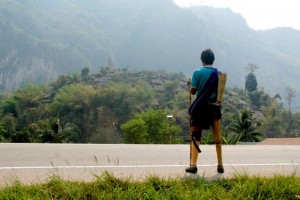More Armed Conflict, More Landmines
By Burma Partnership • April 9, 2013 Last Thursday, 4 April, was International Day of Mine Awareness. While over 80% of the world’s countries have signed or agreed to the 1997 Ottawa Convention banning the use of landmines, Burma is among the 20% who have not. Recent statistics place Burma as the country with the third largest amount of land mine causalities in the world. From 1999 to 2011, over 3,000 men, women and children have lost their lives to mines in Burma. A week and a half ago, two porters, forcibly conscripted by the Burma Army, were killed in Northern Shan State by landmines.
Last Thursday, 4 April, was International Day of Mine Awareness. While over 80% of the world’s countries have signed or agreed to the 1997 Ottawa Convention banning the use of landmines, Burma is among the 20% who have not. Recent statistics place Burma as the country with the third largest amount of land mine causalities in the world. From 1999 to 2011, over 3,000 men, women and children have lost their lives to mines in Burma. A week and a half ago, two porters, forcibly conscripted by the Burma Army, were killed in Northern Shan State by landmines.
Mines are regularly used by both government forces and non-state armed groups. Parts of Northern and Eastern Burma have some of the highest concentration of mines in the world. The Land Mine and Cluster Munitions Monitor identifies over 47 townships in Kachin, Karen, Karenni, Mon, Arakan and Shan States that suffer from mine contamination as well as in Pegu and Tenasserim Regions.
With the recent attempts by the government to initiate ceasefire agreements with ethnic armed groups, there has been talk of refugee return, which has caused great concern among the refugee population over the issue of land mines. In order for refugees to be able to return to Burma safely, there must first be a thorough program to identify and clear mines. This was highlighted in a recent statement by the Karen Refugee Committee, which states in its fourth point, “Relocated areas should be freed from landmines and security should be given a priority.” Furthermore, an officer from the United Nations High Commissioner for Refugees said last week, “There will be no active promotion of return until landmine areas are identified, openly marked and cleared.”
There has been little mine-risk education conducted in the refugee camps along the Thai-Burma border and an increase of mine death is a real concern. “People will be moving as soon as they feel armed conflict has really ended and we expect there will be a spike in mine causalities as a result,” states Yeshua Moser-Puangsuwan of the International Campaign to Ban Landmines.
The equation is clear: there needs to be an end to armed conflict and an agreement to stop planting landmines. Only then can there be proper identification and clearing of existing mines and only then will displaced people be able to return safely to Burma.
Sadly, step one of this path seems further and further out of reach. In the past two weeks, over 1,000 villagers in Northern Shan State have fled their homes due to Burma Army offensives. This is in addition to the almost 100,000 people already displaced by armed conflict in Kachin State, where offensives are occurring nearly every day and the Burma Army continues to send more troops. This fighting resumed less than a week after representatives of the government peacemaking committee and the Kachin Independence Organization (KIO) met in Ruili, China. The next round of talks, originally scheduled for 6 April has been postponed until the end of the month. This is a problem that is getting worse; conflict needs to stop for landmines to be cleared and displaced people return in safety. Instead, conflict is continuing and more mines are being placed.
Mines don’t discriminate between armed combatants and civilians, they don’t discriminate between times of conflict and times of peace. They are a continual reminder of the conflict that continues to take place in Burma today; they are present in the death of family members, in the loss of limbs, in the everyday fear of returning home or of walking in un-cleared areas. There has been enough loss and enough fear in Burma. Armed conflict needs to end, lasting peace needs to begin. There has to be an agreement to end the use of land mines and a clearing of existing land mines. Only then can there be an end to the damage and fear endured by the citizens of Burma caused by decades of armed conflict and its accessories.
Tags: Burma Partnership, Kachin State, Landmines, Shan StateThis post is in: Blog
Related PostsBurma Partnership Celebrates Continuing Regional Solidarity for Burma and Embraces the Work Ahead for Progressive Voice
Burma Army Displays Blatant Disregard for 21st Century Panglong Peace Process
Ann Din Coal Power Plant: Local Movement and Action to Preserve and Protect Natural Resources and Land: Mon IDP Report Case Study #4
Latest Human Rights Abuse Case Demonstrates Urgent Need to Reform the Myanmar National Human Rights Commission
Human Rights Far From Guaranteed as US Sanctions on Burma Are Removed









 All posts
All posts